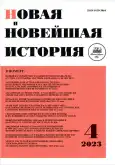Are They Fruits of Ancient or Modern Knowledge? Geographical Discoveries in the Commentary of Heinrich Salmuth to the Treatise of Guido Panciroli “Rerum Memorabilium” (1602)
- Authors: Galkova D.A.1
-
Affiliations:
- Lomonosov Moscow State University
- Issue: No 4 (2023)
- Pages: 89-97
- Section: The age of discoveries and renaissance culture
- URL: https://journals.rcsi.science/0130-3864/article/view/140874
- DOI: https://doi.org/10.31857/S013038640025073-8
- ID: 140874
Cite item
Full Text
Abstract
About the authors
Daria Aleksandrovna Galkova
Lomonosov Moscow State UniversityRussian Federation, Moscow
References
- Галкова Д.А. Сравнительный метод в трактате Гвидо Панчироли «Две книги о достопамятных вещах, теперь уже утраченных и, напротив, недавно остроумно изобретенных» // Исторический журнал: научные исследования. 2022. № 3. С. 58–70. URL: https://cyberleninka.ru/article/n/sravnitelnyy-metod-v-traktate-gvido-panchiroli-dve-knigi-o-dostopamyatnyh-veschah-teper-uzhe-utrachennyh-i-naprotiv-nedavno (дата обращения: 05.06.2023).
- Atkinson C. Inventing inventors in Renaissance Europe. Tübingen, 2007.
- Vecchietti F., Moro T. Biblioteca picena o sia notizie istoriche delle opere e degli scrittori piceni. T. 5. Osimo, 1796.
- Bujanda J. De, Canone M. and E. L’editto di proibizione delle opere di Bruno e Campanella. Un’analisi bibliografica // Bruniana & Campanelliana. 2002. Vol. 8. № 2. P. 451–479.
- Ferguson J. Bibliographical Notes on Histories of Inventions and Books of Secrets. First Supplement. Glasgow, 1894.
- Keller V. Accounting for Invention: Guido Pancirolli's Lost and Found Things and the Development of Desiderata // Journal of the History of Ideas. 2012. № 73 (2). P. 223–245.
- Keller V. Knowledge and the Public Interest, 1575–1725. Cambridge, 2015.
- Pancirollo G., Salmuth H. Rerum Memorabilium iam olim deperditarum & contra recens atque ingeniose inventarum libri duo. Ambergae, 1599–1602.
- Pancirolli G. Raccolta breve d'alcune cose piu' segnalate c'hebbero gli antichi, e d'alcune altre trovate da moderni. Venezia, 1612.
- Tiraboschi G. Biblioteca modenese. T. IV. Modena, 1783.
Supplementary files










